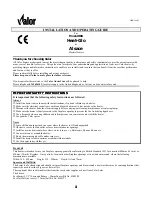
1104UESAGBEN, page 4/31
2. UNIT HEATER
LOCATION
Use the minimum clearances in section 4 and the throw data in the technical data
table addended when determining where to suspend the heater.
Recommended minimum height is 2.5mm.
WARNING
If touched, the vent pipe
and internal heater sur-
faces that are accessible
from outside the heater
will cause burns. Suspend
the heater such that these
components cannot be
touched.
REMARK
Flue requirements may
affect location. Consult
section 6 before making a
fi
nal determination.
For best results, the heater should be placed with certain rules in mind. Always
ensure that minimum clearances are maintained. Locating a unit heater above
the maximum recommended height can result in signi
fi
cant air strati
fi
cation.
When possible, heaters should be arranged to blow toward or along exposed
wall surfaces.
Suspended heaters are most effective when located as close to the working zone
as possible, but care should be exercised to avoid directing the discharged air
directly on occupants.
Partitions, columns, counters, or other obstructions should be taken into consid-
eration when locating the unit heater so that a minimum quantity of air
fl
ow will be
de
fl
ected by such obstacles.
When units are located in the centre of the space to be heated, the air should
be discharged toward the exposed walls. In large areas, units should be located
to discharge air along exposed walls with extra units provided to discharge air
in toward the centre of the area. For optimum results heaters are best used in
conjunction with recirculating air fans suspended at high level.
At those points where in
fi
ltration of cold air is excessive, such as at entrance
doors and shipping doors, it is desirable to locate the unit so that it will dis-
charge directly toward the source of cold air, typically from a distance of 4.5 to
6.0 meters or install a down
fl
ow unit over the door opening.
CAUTION
Do not locate the heater
where it may be exposed
to water.
Hazards of Chlorine - applies to the location of the combustion air inlet
The presence of chlorine vapours in the combustion air of gas-
fi
red heating
equipment presents a potential corrosion hazard. Chlorine, found usually in the
form of freon or degreaser compounds when exposed to a
fl
ame will precipitate
from the compound, and go into solution with any condensation that is present
in the heat exchanger or associated parts. The result is hydrochloric acid which
readily attacks all metals. Care should be taken to separate these vapours from
the combustion process. This may be done by wise location of the unit
fl
ue and
combustion air terminals with regard to exhausters or prevailing wind directions.
Chlorine is heavier than air. Keep this fact in mind when determining installation
location of the heater in relation to building extract systems.
3. UNCRATING &
PREPARATION
This unit was test operated and inspected at the factory prior to crating and was
in proper operating condition. If the heater has incurred damage in shipment,
document the damage with the transport company and contact your supplier.
Check the rating plate for the gas and electrical speci
fi
cations of the heater to be
sure that they are compatible with the gas and electric supplies at the installation
site.
Read this booklet and become familiar with the installation requirements of your
heater. If you do not have knowledge of local requirements, check with the gas
supplier and any other local agencies who might have requirements concerning
this installation.
Before beginning, make preparations for necessary supplies, tools, and man-
power.
If the installation includes optional vertical louvres or downturn nozzle etc.,
install these options before the heater is suspended. Follow the instruc-
tions included in the option package.





































